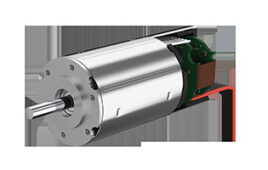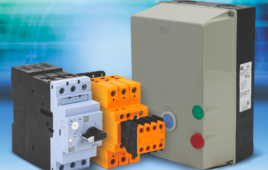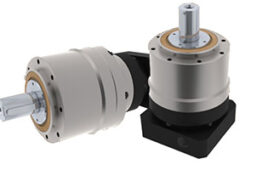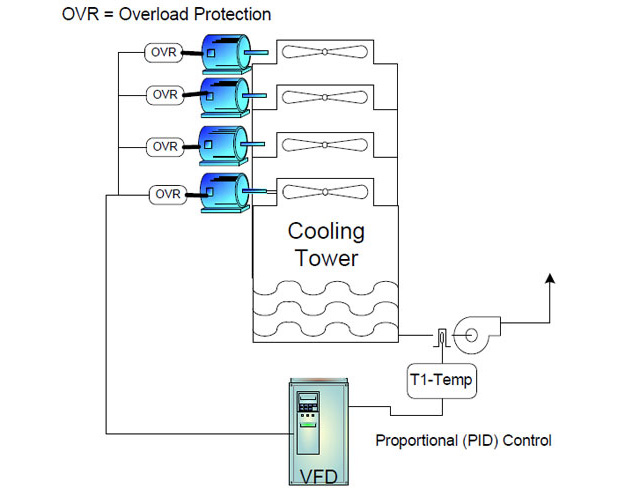By Tom Wyatt
Production Manager, Automation Division
HEIDENHAIN Corporation
Schaumburg, Ill.
High feedback loop gain is one of several critical parameters frequently needed for precision servo drives in automation equipment, robots, handling systems, machine tools, and various production
machines to ensure that the control system can make accurate moves with stable speeds. And because position encoders are the most widely used sensors that provide the feedback signal, they play a crucial role in the drive’s control quality.
The type of encoder selected for an application depends on the precision needed. High-resolution position data and accurate error measurements must be available to the controller within one signal period for best feedback control. Also, when designing a system, consider that in addition to a precision encoder, a uniform data interface and a flexible motor mounting for the controller will accommodate a wider variety of encoders and drive assemblies.

This is a typical block functional diagram of a control system with encoder outputs. The effect of the interpolation errors in the control loop of a servo drive is shown in the graphs at two different speeds. The position accuracy and speed stability of the machine axes significantly determine the quality of the work pieces. Speed instability can come from the drive train and position errors from the encoder. Higher resolutions and accuracies can decisively improve the speed stability of the motor. When the resolution of the measured signal is too low or the interpolation error is too high, wave-like markings can appear on the work piece surface.
Position encoder types
Three types of encoders are most often used for position control; resolvers, inductive rotary encoders, and optical rotary encoders. The unique features of each encoder type differs significantly and justifies which is best suited for a specific application. For example:
• Resolvers typically deliver only one signal period per motor revolution, so the position resolution is quite limited, and the position value is absolute within one revolution.
• Inductive rotary encoders come with graduations of 16 or 32 signal periods per revolution and provide a significantly higher position resolution. The angular position is determined as an absolute value.
• Optical rotary encoders are based on extremely fine graduations of 512 or 2048 signal periods, so they have much higher resolutions. The multiple turn versions of both inductive and optical rotary encoders can determine the absolute position within 4096 revolutions.

Optical and inductive rotary encoders come with Heidenhain’s built-in “EnDat 2.2” digital interface. The controller accepts the encoder’s digitized, absolute-position output value directly, without additional calculations. Resolvers, on the other hand, require more circuitry to evaluate their analog signals. Although resolvers are well-known for their robustness, these rotary encoders can respond to higher accelerations.
Periodic errors
In order to achieve the high resolution required, the sinusoidal scanning signals must be interpolated. Inadequate scanning, measuring standard contamination, and insufficient signal conditioning can make the signals deviate from the ideal sinusoidal shape. During interpolation, errors then develop whose cycle is within one signal period. This position error is also called “interpolation error.” On high-quality encoders they are typically 1% to 2% of the signal period.
Interpolation errors adversely affect position accuracy, significantly degrade the speed stability, and increase the drive’s response to noise. Also, these errors determine the nominal amount of current the speed controller calculates to brake or accelerate the drive. At low feed rates the drive’s response lags the interpolation error, and at higher speeds the frequency of the interpolation error increases. Because the motor can follow the error only within the control bandwidth, its affect on the speed stability decreases as the speed increases. However, the disturbances in the motor current continue to increase, which likewise produces disturbing noises in the drive at high
control-loop gains as shown in the graphs under the system block diagram.

Servo drives must be able to operate under different accuracy requirements. Since the required accuracy significantly influences the selection of the encoder type, a universal mounting should be used for a versatile and modular drive system. Ideally, all different types of encoder variants–optical and inductive rotary encoders as well as resolvers–can be mounted on a motor without additional, intermediate flanges. This is one suggestion for a universal type of mounting for optical and inductive rotary encoders and resolvers on a servo motor.
The accuracy that a servo drive can attain depends on both the amplitude and the period of the measuring error. The resolver generates only one signal period per revolution, so the interpolation error has a large effect: Using the values from the table and a control bandwidth of 100 Hz, the drive follows a sinusoidal interpolation error whose period corresponds to one signal period of the encoder (1-f error), up to 6000 rpm. This means that speed fluctuations can be expected at any speed.
With an optical rotary encoder the drive lags an interpolation error only at low speeds. Using the same example, but with a rotary encoder with 2048 lines, a 1-f error becomes apparent in a speed range between 0 and 2.8 rpm.
Position resolution effects
Since the resolution and accuracy of encoders typically used on servo drives are often different, the influence of the smallest possible measuring step on the control loop is examined more closely in the example shown in the simplified illustration of a control loop. The main influence of limited position resolution can be estimated by considering the proportional speed gain only. The position controller and the integral speed loop can be neglected. A drive with the following specifications is considered:

Electrical current variations for different types of encoder scanning systems are compared for resolvers, optical encoders, and inductive encoders. Disturbances in the motor current are reduced significantly with higher resolution encoders. The motor then operates quietly and develops only a small amount of heat.
Sampling interval, T = 100 µs
P-gain, KPG = 600 s-1
Motor inertia, JM = 0.001 kgm2
Torque constant, KKM = 0.68 Nm/A
Within these parameters, the minimum possible measuring step on a resolver with 14-bit lagging interpolation generates a 3.4-A nominal current jump. This is 50% of the peak current of the motor being considered. On the other hand, the significantly smaller measuring step on an inductive rotary encoder with 17-bit resolution produces only a 400-mA jump, and an optical rotary encoder with 25-bit resolution, produces less than a 2-mA jump.

These rotary encoders are optimized for use on motors in automation industries as well as in drives for production and machine tools. Their significant advantages are short overall lengths, torsionally rigid couplings, and high resolutions. Their EnDat intelligent interface permits a high degree of modularity. It doesn‘t just transmit the absolute position values, but also temperature and diagnostic information, test values, and other parameters such as those used for automated commissioning. It then has increased reliability through digital transmission of the position values. The EnDat interface supports the automated commissioning of drives, and can reduce standstill times in case service may be needed. Moreover, the simple, low-cost cabling of the EnDat interface simplifies the plant project planning effort for the mechanical equipment.
HEIDENHAIN Corporation
www.heidenhain.de
::Design World::
Filed Under: Drives (servo) + amplifiers, Encoders • optical, Encoders (rotary) + resolvers, Motion control • motor controls





Tell Us What You Think!